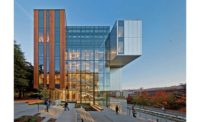Want to See More Photos?
ENR 2024 Photo Contest Slideshow
Wars and political tensions are escalating, and so is migration. Also on the rise are expectations that artificial intelligence will transform life and business as we know it. But it is worth noting right away that the escalator—a more-than-100-year-old wonder of mechanical engineering—also is a de-escalator that provides downward transit for a continuous flow of people. We need a lot of both.
Ever since the escalator first went into use around 1896, it has transformed our sense of space. No longer limited to an elevator cab or a staircase, humans were able to ride a kind of mechanical carpet out in the open and penetrate big interior spaces—reaching new levels inside a structure with comparative ease and at times an enlightening wide perspective. Who has not enjoyed the ride up a department store escalator gazing down on meadows of suits and dresses? Does stepping on and off moving treads stop being at least a little fun at any age?
Escalators are so critical to intra-building mobility that there could not be a major airport or multi-platform train station or transportation hub without them. Over the years, we have come to appreciate the good, and some of the bad, that such a system brings. We know every modern miracle since the use of fire has had a downside. You or your clothing can be caught in the tread, and fires and accidents have occurred. Who has not experienced a situation where someone fell backward on an escalator or there was a pileup at the top or bottom because of people not entering or exiting fast enough?
Escalation, as well as de-escalation, were both a big part of the recently completed construction year. Industry needed material cost inflation to de-escalate somewhat, and it has, as have interest rates. Unfortunately, new building construction plans have also slowed considerably—and hopefully that market sector has a parachute strapped on and doesn’t crash land.
But to be honest, the fundamental tensions of business life still seem to be heading up: How can designers produce accurate and high-quality plans with so much emphasis on speed and cost? Will young people turn their careers to design and construction work in sufficient numbers to meet industry need?
Finally, will government and industry be able to properly maintain the once-magnificent but aging physical infrastructure the world already has, which includes vertical transportation? Certainly, one of the biggest frustrations of anyone’s day is when you expect an escalator you see to take you somewhere—especially up if you’re tired or late—and it isn’t working. That’s a real downer.





Post a comment to this article
Report Abusive Comment